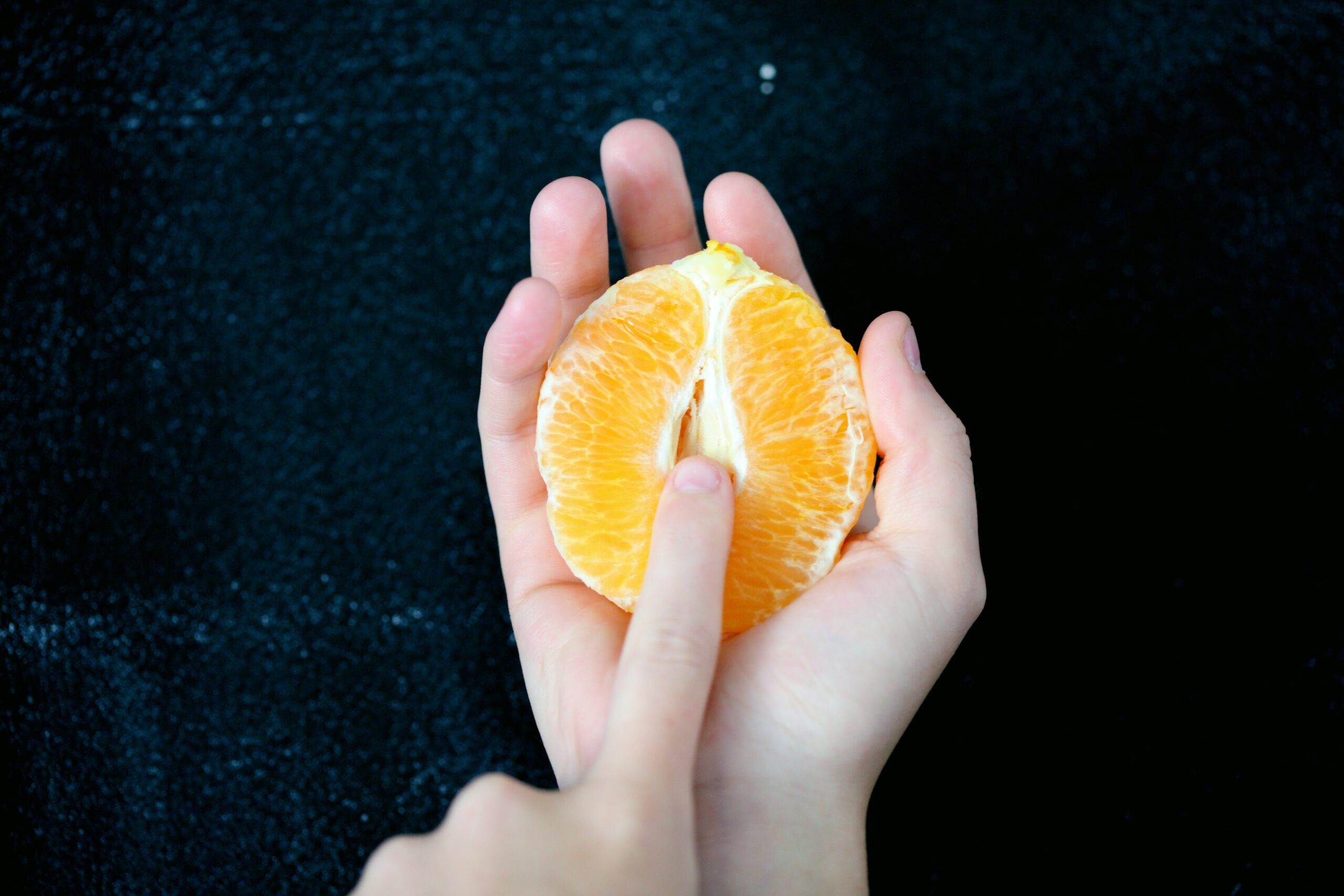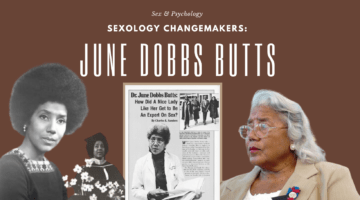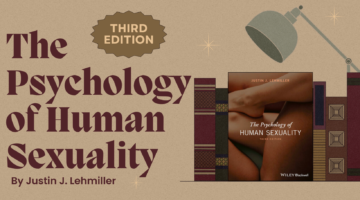Do Women Experience Less Sexual Pleasure Than Men?
October 5, 2023 by Merissa Prine
Sex and Psychology’s Dr. Justin Lehmiller was the recipient of the inaugural Ellen Laan Award for Translational Sexual Science from the International Academy of Sex Research (IASR) this summer. Ellen was a prominent figure in the field of sex research, known for her significant contributions to the study of sexual function and behavior. Through her research, she advocated for a more holistic and inclusive approach and helped to illuminate the complexities of sexual arousal, desire, and pleasure. Sadly, Ellen passed away last year; however, her pioneering research continues to have an indelible impact on the field. For today’s blog post, we wanted to highlight some of her important work.
Do Women Experience Less Sexual Pleasure Than Men?
One of the last articles Ellen published was titled, “In Pursuit of Pleasure: A Biopsychosocial Perspective on Sexual Pleasure and Gender” [1]. This article describes the complex interplay between sexual pleasure and gender, while emphasizing the importance of considering biological, psychological, and social factors in understanding human sexuality.
Sexual pleasure is a fundamental aspect of human sexuality that has been a focus of sexuality research for years. Pleasure is a complex and multifaceted aspect of human life, and we are going to unravel some of the intricacies of it below.
The Biopsychosocial Model
As Ellen and her co-authors describe, pleasure is something that must be viewed through a broad lens that incorporates biological, psychological, and social factors, such as the biopsychosocial model. Sexual pleasure is a product of so much more than our anatomy and physiology: it is a manifestation of myriad factors that combine in unique ways in a given situation.
When it comes to the intersection of gender and pleasure, what we see from the research is that men and women are similar in their biological capacity to experience pleasure; however, there are gender-based restraints on women’s sexual pleasure, particularly in the context of heterosexual relationships.
Gender, Desire, and Pleasure
The accumulated evidence suggests that gender differences in men’s and women’s ability to experience sexual pleasure is quite small. For example, data from brain imaging (fMRI) studies examining over 1,800 participants’ brains while viewing sexual stimuli found that women’s and men’s brains were similarly responsive [2].
In terms of sexual desire, historically, this has been defined in terms of spontaneous desire (i.e., desire that emerges “out of the blue”). Studies that have relied on this definition have found substantial gender differences in desire, such that men report higher levels of it [3]. However, when researchers include definitions of desire that also encompass responsive desire (i.e., desire that arises in response to a stimulus), there are no significant differences between men’s and women’s desire. In other words, there were observed differences between genders because the earlier definitions did not adequately capture many women’s experiences of desire. When a more encompassing definition is used, we no longer see significant gender differences in levels of sexual desire.
The Pleasure Gap
Despite the evidence that women have the same capacity for sexual pleasure as men, there remains a “pleasure gap,” which is the phenomenon whereby heterosexual women experience less sexual pleasure than their male partners. The authors offer a few examples of why this might be the case: 1) heterosexual women are having sex that does not prioritize their pleasure and 2) sex comes with disproportionate social consequences for women.
The clitoris is the main pleasure organ for cisgender women. However, women are often expected to experience sexual pleasure (and orgasm) from penile-vaginal sex that does not adequately stimulate their clitoris. In contrast, lesbian women have been found to experience orgasm far more often than heterosexual women, which seemed to be related to the fact that lesbians were much more likely to stimulate their partner’s clitoris [4].
Unfortunately, there are still very real gendered expectations in terms of the way women “should” behave sexually. Both men and women are susceptible to moral disapproval based on their sexual behavior. In one study, women who accepted casual sex were judged more negatively than men [5]. Women are aware of these social consequences and take them into consideration before engaging in sexual activity.
In Ellen’s words, “when these contextual and sociocultural factors are removed and opportunities for sexual pleasure are increased, the sexual pleasure gender gap is likely to be removed as well.” [1]
Closing the Pleasure-Gap
Moving forward, it is important to recognize that this pleasure gap is not the result of women’s inability to experience pleasure. Rather, it is a symptom of neglecting her true erotic potential. The authors note a number of takeaways for how we can help foster more egalitarian pleasure:
- Move towards a discourse of gender similarities rather than gender differences.
- Provide pleasure-prioritized sex education in which individuals openly learn about how to experience pleasure and gain knowledge about the clitoris.
- Include diversity in sexual orientation and gender identity in sex education to minimize heteronormativity and the coital imperative (i.e., the emphasis on penile-vaginal sex).
In conclusion, “In Pursuit of Pleasure” offers a comprehensive view of sexual pleasure, considering the intricate interplay between biology, psychology, and society/culture. By adopting this holistic approach, it is clear that sexual pleasure in not absent in women. Rather, a variety of factors impact women’s ability to fully embrace their pleasure potential. We can move towards a more equal and fulfilling sexual landscape through education, understanding, and exploration.
Once again, we would like to extend our gratitude to Dr. Ellen Laan for her invaluable research contributions to the field of human sexuality.
Want to learn more about Sex and Psychology? Click here for more from the blog or here to listen to the podcast. Follow Sex and Psychology on Facebook, Twitter (@JustinLehmiller), or Reddit to receive updates. You can also follow Dr. Lehmiller on YouTube and Instagram.
References
[1] Laan, E. T. M., Klein, V., Werner, M. A., van Lunsen, R. H. W., & Janssen, E. (2021). In pursuit of pleasure: A biopsychosocial perspective on sexual pleasure and gender. International Journal of Sexual Health, 33(4), 516–536. https://doi.org/10.1080/19317611.2021.1965689
[2] Mitricheva, E., Kimura, R., Logothetis, N. K., & Noori, H. R. (2019). Neural substrates of sexual arousal are not sex dependent. Proceedings of the National Academy of Sciences of Sciences, 116(31), 15671–15676. https://doi. org/10.1073/pnas.1904975116
[3] Dawson, S. J., & Chivers, M. L. (2014). Gender-specificity of solitary and dyadic sexual desire among gynephilic and androphilic women and men. The Journal of Sexual Medicine, 11(4), 980–994. https://doi.org/10.1111/jsm. 12430
[4] Rees, J. C., van Spiering, M., & Laan, E. (2016). Orgasm consistency of lesbian and heterosexual women during partnersex: The role of clitoral stimulation. Tijdschrift Voor Seksuologie, 40, 68–75.
[5] Conley, T. D., Ziegler, A., & Moors, A. C. (2013). Backlash from the bedroom: Stigma mediates gender differences in acceptance of casual sex offers. Psychology of Women Quarterly, 37(3), 392–407. https://doi.org/10.1177/ 0361684312467169
Image credits: Alexander Grey via Unsplash

Dr. Justin Lehmiller
Founder & Owner of Sex and PsychologyDr. Justin Lehmiller is a social psychologist and Research Fellow at The Kinsey Institute. He runs the Sex and Psychology blog and podcast and is author of the popular book Tell Me What You Want. Dr. Lehmiller is an award-winning educator, and a prolific researcher who has published more than 50 academic works.
Read full bio >


